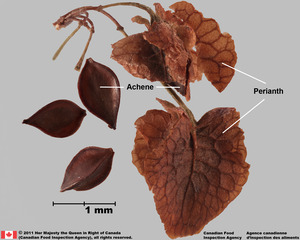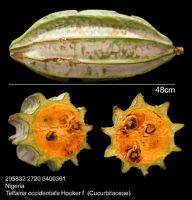Content is from Kirkbride et al. 2006Kirkbride et al. 2006:
Kirkbride JH, Jr, Gunn CR, and Dallwitz MJ. 2006. Family guide for fruits and seeds, vers. 1.0. Accessed September 2020-January 2022. URL: https://nt.ars-grin.gov/seedsfruits/keys/frsdfam/index.cfm ., without modification.
Updates are forthcoming.
Fruits: Pistil(s) simplesimple:
fruit formed from a single flower with one pistil, solitary carpel or several fused carpels
; 1; 1-pistillate. Fruit anthocarpanthocarp:
simple or compound and including some tissue of non-ovarian origin (accessory tissue) ; simplesimple:
; simplesimple:
fruit formed from a single flower with one pistil, solitary carpel or several fused carpels
; diclesium; without persistent central column; within accessory organ(s); within perianthperianth:
collective term for calyx and corolla of a flower
 (assumed); 1-seeded; 1-seeded; less than 1 cm long; 0.4–0.5 cm long; with 1-carpellate (assumed); not sulcatesulcate:
(assumed); 1-seeded; 1-seeded; less than 1 cm long; 0.4–0.5 cm long; with 1-carpellate (assumed); not sulcatesulcate:
surface relief—having one or more elongate, relatively narrow and shallow depressions or grooves ; in transectiontransection:
; in transectiontransection:
a cross section; representing a plane made by cutting across an organ at a right angle to its length tereteterete:
tereteterete:
approximately circular in cross section; width and thickness approximately equal
 ; apexapex:
; apexapex:
the point farthest from the point of attachment, or the "tip" of an organ not beaked; indehiscentindehiscent:
not beaked; indehiscentindehiscent:
not opening on its own, as in a fruit
 . Epicarpepicarp:
. Epicarpepicarp:
outer layer of fruit wall or pericarp, if divided into layers; note here used synonymously with exocarp brown (all shades) (assumed); dulldull:
brown (all shades) (assumed); dulldull:
reflecting only a low proportion of incident light, with no apparent sheen ; durable; coriaceouscoriaceous:
; durable; coriaceouscoriaceous:
texture—leathery
; when mature glabrousglabrous:
without hairs
, or not glabrousglabrous:
without hairs
(with hairs) (when immature - minutely stellatestellate:
star-shaped; with radiating branches pubescentpubescent:
pubescentpubescent:
surface relief—bearing hairs
); hairs short; hairs not glandularglandular:
surface relief—covered with small, raised secretory glands, regular or irregularly shaped, translucent or opaque, and maybe distinctly colored ; without armature; with wing(s); 1-winged; with wing(s) laterallateral:
; without armature; with wing(s); 1-winged; with wing(s) laterallateral:
(of embryo) embryo lies along the side of the seed, generally towards one end; of, at, or from the side; in grasses, can refer to the sides adjacent to the dorsal and ventral sides
; without apicalapical:
at or pertaining to the end of the seed or fruit distal from its point of attachment (i.e., base)
respiratory hole. Mesocarpmesocarp:
the middle layer of the pericarp, if divided into layers absent. Funiculusfuniculus:
absent. Funiculusfuniculus:
(alt. funicle) stalk connecting the ovule (later seed) to the ovary (later fruit) placenta short; short without seed bearing hooks (retinacula); not persisting in fruit after seed shed.
short; short without seed bearing hooks (retinacula); not persisting in fruit after seed shed.
Seeds: Arilaril:
(broad sense) appendicular structure that wholly or partly envelops a seed and is produced from or a modification of the funicle, raphe, or outer integument; usually fleshy or pulpy, sometimes spongy or tufted-capillate, often brightly colored absent. Seed larger than minute; 1 to less than 5 mm long; 1.8–2.2 mm long (diameter); circularcircular:
absent. Seed larger than minute; 1 to less than 5 mm long; 1.8–2.2 mm long (diameter); circularcircular:
(of embryo) linear embryo is curved into an "O" shape (or nearly so); in transectiontransection:
(or nearly so); in transectiontransection:
a cross section; representing a plane made by cutting across an organ at a right angle to its length flattened; not bowl shaped; not nutlike; without winglike beakbeak:
flattened; not bowl shaped; not nutlike; without winglike beakbeak:
a usually firm, terminal appendage, sometimes tapered ; without caudatecaudate:
; without caudatecaudate:
tapering to a long, tail-like appendage appendage(s); at maturity with food reserves (based on Chenopodiaceae); with perispermperisperm:
appendage(s); at maturity with food reserves (based on Chenopodiaceae); with perispermperisperm:
seed nutritive tissue comparable to the endosperm, but derived from the nucellus (maternal tissue)
(based on Chenopodiaceae); without canavanine. Sarcotestasarcotesta:
pulpy or fleshy outer layer of the seed coat, simulates aril absent. Testatesta:
absent. Testatesta:
seed coat
 present; without markedly different marginalmarginal:
present; without markedly different marginalmarginal:
at, on, or close to the margin or border
tissue; without fleshyfleshy:
texture—fairly firm and dense, juicy or at least moist, and easily cut
or leatheryleathery:
texture—moderately thick, tough, and very pliable
layer over hard layer; without crease or line separating cotyledons from hypocotyl-radicle; without notch along margin where cotyledons from hypocotyl-radicle tip approach each other; without glands; without bristles; glabrousglabrous:
without hairs
; without wings; without collar; without operculumoperculum:
a dehiscent cap (or lid) of a seed or fruit that opens during germination or dehiscence
 ; colored; monochrome; brown (all shades); not becoming mucilaginousmucilaginous:
; colored; monochrome; brown (all shades); not becoming mucilaginousmucilaginous:
resembling mucilage; moist and sticky
when wetted. Perispermperisperm:
seed nutritive tissue comparable to the endosperm, but derived from the nucellus (maternal tissue)
opaqueopaque:
not transmitting light
. Embryo differentiated from food reserve; well developed; 1 per seed; completely filling testatesta:
seed coat
 (no food reserve); at one end of seed not extending into a depression or cup; peripheralperipheral:
(no food reserve); at one end of seed not extending into a depression or cup; peripheralperipheral:
(of embryo) embryo is curved around the outer edge of the seed, near the seed coat
; linearlinear:
(shape) long, narrow, and uniform in width; (of embryo) embryo is straight and much longer than wide ; annularannular:
; annularannular:
3D shape—forming a ring (or nearly so); with cotyledons gradually connected to hypocotyl-radicle; without coleorhiza; without simmondsin; without stomata; not green; with 2 or more cotyledons. Cotyledons 2; well developed; 0.5 times length of embryo; as wide as hypocotyl-radicle; 1 times wider than hypocotyl-radicle; not concealing hypocotyl-radicle; not foliaceous; thinthin:
(or nearly so); with cotyledons gradually connected to hypocotyl-radicle; without coleorhiza; without simmondsin; without stomata; not green; with 2 or more cotyledons. Cotyledons 2; well developed; 0.5 times length of embryo; as wide as hypocotyl-radicle; 1 times wider than hypocotyl-radicle; not concealing hypocotyl-radicle; not foliaceous; thinthin:
having or being of relatively little depth
; flat; smooth; with apicesapex:
the point farthest from the point of attachment, or the "tip" of an organ entire; with margins separate; basally entire; equal in size; not punctatepunctate:
entire; with margins separate; basally entire; equal in size; not punctatepunctate:
surface relief—dotted with pits or with translucent, sunken glands or with colored dots, similar to pitted dotted. Hypocotyl-radicle well developed; straight; not thickened.
dotted. Hypocotyl-radicle well developed; straight; not thickened.
Literature specific to this family: Correll, D.S. & H.B. Correll. 1972a. Aquatic and wetland plants of southwestern United States, vol 1, pp. 841–842. Stanford University Press, Stanford; Hitchcock, C.L., A. Cronquist, M. Ownbey, & J.W. Thompson. 1964. Vascular plants of the Pacific northwest, part 2, pp. 213 & 215. University of Washington Press, Seattle.